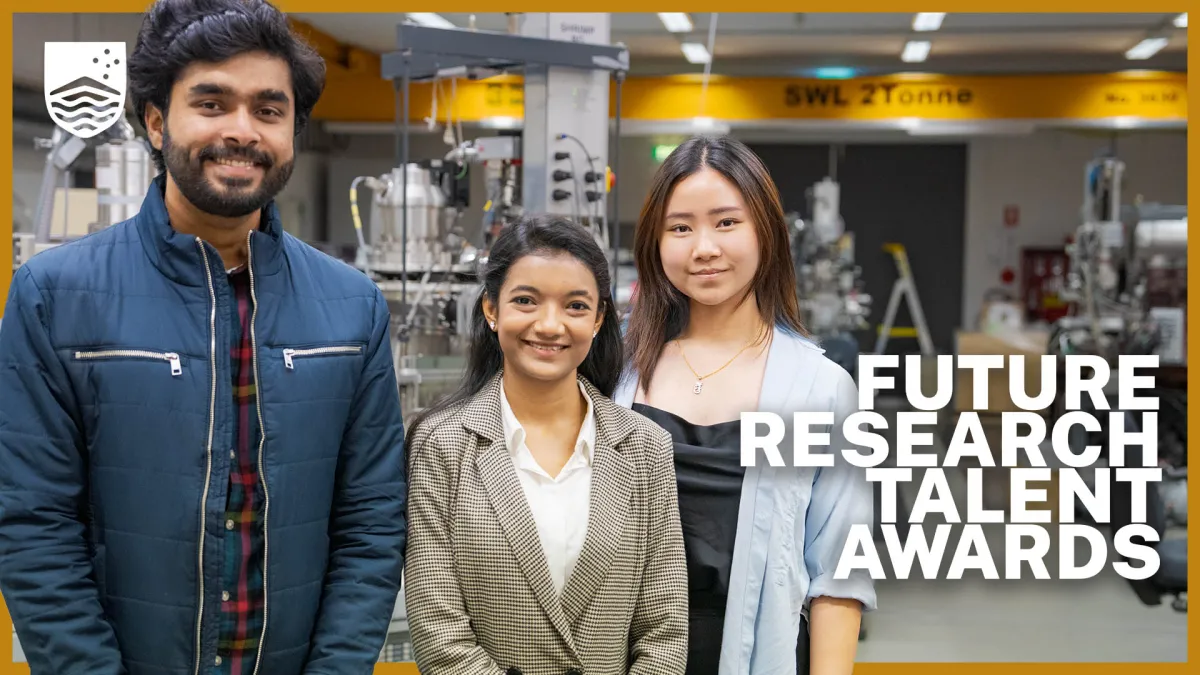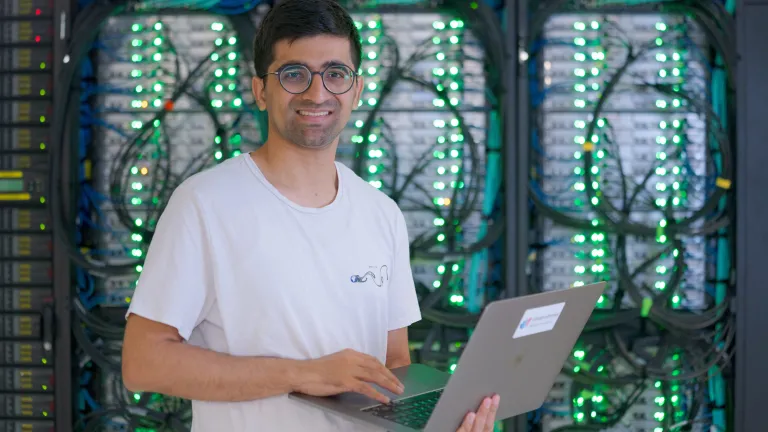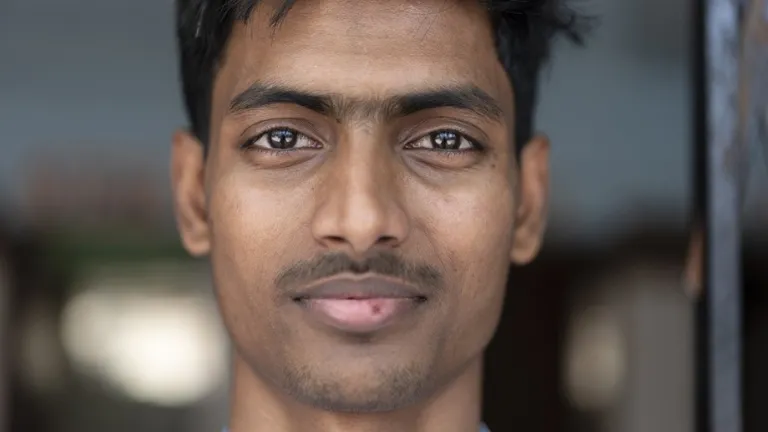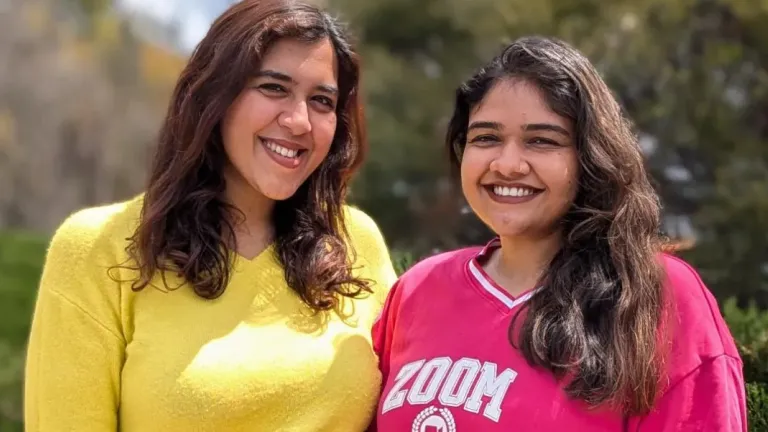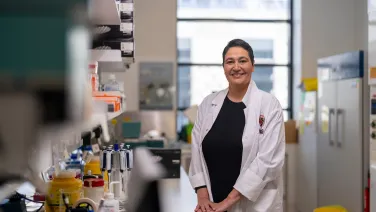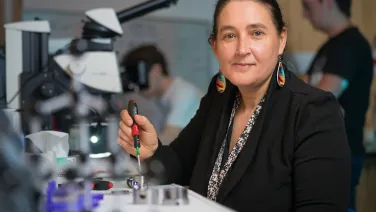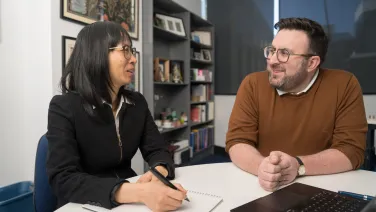
Future Research Talent Awards - Indonesia
Update: Seven scholars from five Indonesian institutions have been selected to undertake research projects at ANU as part of the 2025 FRT Program. These scholars come from the following collaborating institutions in Indonesia: List of collaborating institutions - Indonesia
This note and the webpage will be updated when selection process for the 2026 round of the FRT program opens later this year.
The Future Research Talent (FRT) awards are jointly offered by ANU College of Science and Medicine, ANU College of Systems and Society and ANU College of Law, Governance and Policy to staff and students from Indonesia.
The FRT is a competitive and prestigious program that attracts the best staff and students from top-tier Indonesian institutions. The program offers a valuable opportunity for Indonesia’s emerging research talent to form international connections and develop research skills at one of the world's leading universities (ANU is ranked #30 in the world in QS World University Rankings 2025).
Hear from our FRT cohort
Value and benefits
The value of each FRT award is A$8,500.
FRT awards provide selected Indonesian staff and students with an opportunity to travel to ANU to pursue collaborative research, for a period of 10-12 weeks, in a range of Sciences, Technology, Engineering, Mathematics, and Medical research disciplines.
The amount offered under the FRT program must be utilised to directly support the recipient’s participation in collaborative research at the ANU College of Science and Medicine, ANU College of Systems and Society, and ANU College of Law, Governance and Policy and may be allocated towards costs associated with, but not limited to return airfare, visa (including any associated medical expenses), travel insurance, accommodation, and general living expenses. The management of award funds is the responsibility of the recipient.
Eligibility
Awards are offered under two distinct categories:
- Students: undergraduate and postgraduate students at partner institutions.
- Staff: Academic faculty members at selected universities/institutions and research-focused staff employed at selected government departments.
Collaborating institutions in Indonesia may be invited to nominate candidates for only one or both categories. Details on which category/categories an institute can nominate candidates for will be provided to collaborating institutions directly.
To be eligible for an FRT award, the candidate must:
- be a citizen of Indonesia residing in Indonesia;
- be able to demonstrate a high level of academic ability and research potential;
- be an academic staff member or a student enrolled in a program at a collaborating institution in Indonesia;
- be nominated for award consideration by a collaborating Indonesian institution specified by the ANU College of Science and Medicine, ANU College of Systems and Society, and ANU College of Law, Governance and Policy;
- be seeking to undertake a research project in one of the specific fields of research proposed by the ANU College of Science and Medicine, ANU College of Systems and Society, and ANU College of Law, Governance and Policy; and,
- have not previously received an FRT award from the ANU College of Science and Medicine, ANU College of Systems and Society, and ANU College of Law, Governance and Policy.
In exceptional circumstances, applications from students enrolled at institutions other than the selected partner institutions may be permitted at the discretion of the Dean of either of the three Colleges, at the request of a Research School Director.
Research Projects
The following research projects or areas or groups, arranged under diverse disciplinary areas that they belong to, are available / open to hosting scholars as part of the 2025 FRT program.
Astronomy and Astrophysics
| Research Project /area / group | Description | ANU Supervisor/s |
|---|---|---|
| Computational astrophysics studies in turbulence, magnetic fields, and star/galaxy formation and evolution | We study the statistics of turbulent, magnetised gases, relevant for the structure and evolution of the interstellar medium, the formation and evolution of stars and galaxies. We use a combination of supercomputer simulations, theory, analytical calculations, and comparison to observations. | Professor Christoph Federrath |
| Science Simulation and Instrument Modelling for the UVESS Small Satellite Mission | At ANU, in collaboration with international partners, we are developing a small satellite mission concept called UVESS (Ultraviolet Extinction Sky Survey). The mission aims to explore the composition of the interstellar medium (ISM) by mapping the variation in UV extinction curve slopes and the 2175 A feature across much of the sky, providing insights into the makeup and characteristics of the ISM. The aim of the project is to advance the mission concept and instrument design and analysis. The project broadly covers UV sky simulation, development of the instrument concept, electro-optical modelling, and system design. The scope is flexible and can be tailored to focus on areas of interest for students. Background in scientific programming (eg: python) and data analysis is required | Dr Joice Mathew, Dr Andrew Battisti, Dr Israel Vaughn |
| Stellar physics and its observables # | Explore the imprint of suppressed dipole modes in the spectra of red giant stars. | A/Prof Luca Casagrande and Dr Jie Yu |
| Magnetic fields in galaxies # | Using numerical simulations and radio observations to determine the strength, scale, and structure of magnetic fields in the Milky Way and nearby galaxies. | Dr Amit Seta |
| Unveiling the Cosmic (Rays) Secrets with "QED" simulations | Cosmic rays (CRs) play a critical role in galaxy evolution, yet key questions about their physics remain unanswered. This project will use the suite of state-of-the-art hydrodynamic simulations called “QED” to explore how supernova-driven outflows can constrain CR properties. Through this project, you will gain hands-on experience with processing high-resolution simulation data and develop insights on CR properties in galactic environments. | Dr Aditi Vijayan, A/Prof Roland Crocker, Prof Mark Krumholz |
| Tailored framework for literature review | The rapid expansion of astronomical literature makes it increasingly difficult for researchers to synthesize relevant insights and keep pace with the latest findings. This project seeks to address this challenge by leveraging large language models (LLMs) to enable more effective semantic searches tailored to the needs of a specific research group with deep domain expertise. | Dr Yuxiang Qin |
| HST and JWST deep photometry of Globular clusters and Ultra-faint Dwarf galaxies # | Study of low-mass stars using deep Hubble Space Telescope and James Webb Space Telescope infrared observations of Galactic Globular clusters and Ultra-faint dwarf galaxies. | Dr Giacomo Cordoni |
# Projects / groups that are open to hosting staff and undergraduate & postgraduate students.
Biological Sciences
| Research Project / area / group | Description | ANU Supervisor/s |
|---|---|---|
| Expanding pipesnake | Extend the phylogenomics software pipesnake to enable greater user flexibility, data reporting, and more efficient processing. Goals are flexible and can be adapted to suit the interests of the scholar. | Dr Ian Brennan, Dr Sarin Tiatragul, Professor Scott Keogh |
| Bioinformatics Reference Genome Annotation | A bioinformatics project where the scholar will learn to assemble and annotate reference genomes for several Australian reptiles. Long read data will need to be assembled, polished and prepared before being annotated using the NCBI pipeline. | Dr Mitzy Pepper |
| Use of wheat protoplasts to identify novel pathogenic proteins in pathogenic fungi. # | Plant pathogenic fungi are responsible for billions of dollars of losses in agriculture and are a serious threat to global food security. To facilitate disease, these pathogenic fungi secrete proteins during infection that manipulate plants to cause disease. This project will exploit an emerging technique of exploiting the response of wheat protoplasts to a library of fungal pathogen proteins to identify new mechanisms of disease. | Professor Peter Solomon and Dr Erin Hill |
| RNA binding proteins for hybrid breeding in crops | Genetic and molecular characterisation of RNA binding proteins involved in fertility restoration in plants. | Dr Joanna Melonek |
| Leveraging Plant Developmental Regulators to Improve Regeneration in Recalcitrant Crops # | At our Training Centre for Future Crops Development, we use CRISPR/Cas gene editing to modify genes of interest. However, plant regeneration remains a challenge due to genotype and species dependencies. In this project we aim to study how developmental regulators can enhance regeneration across various commercial crop varieties. Experience in cloning plant tissue culture is preferred | Dr Hendry Susila and Professor Barry Pogson |
| Tracking the evolution of honeybee pathogens # | Rarely are you able to see an ecosystem-changing event about to happen and be in the right place to study it. This is happening in Australia, where the arrival of parasitic mites is going to wipe out most honeybees in the coming years, with wide-ranging agricultural and environmental effects. We have a wide range of projects studying how these parasites will drive ecological and evolutionary change. | Professor Sasha Mikheyev |
| Eco-evolutionary studies on impacts of climate change on native Australian plant species # ^ | Plants have remarkable capacity to tolerate and respond to the warmer temperatures, changing precipitation and fire regimes, and increased occurrence and intensity of heatwaves associated with climate change via physiological tolerance, phenotypic plasticity, and evolutionary adaptation. We seek to understand how shifts in climatic conditions push plants toward tipping points and beyond their physiological limits, and the implications of this for ecological function and persistence. | Professor Adrienne Nicotra |
# Projects / groups that are open to hosting staff and undergraduate & postgraduate students.
^ This research project can be extended, and supported with additional funding, beyond the standard duration (12 weeks) of the FRT program. For details, please see the project description.
Chemistry
| Research Project / area / group | Description | ANU Supervisor/s |
|---|---|---|
| Novel Peptide-Based Therapeutics ^ | Constrained peptides fill an important area of chemical space between small molecule therapies and larger antibodies. Constraining a peptide by macrocyclization or stapling can enhance metabolic stability, promote biological uptake across cell membranes, and increase binding affinity. The Nitsche group at the ANU Research School of Chemistry has a strong interest in developing new biocompatible methods to constrain peptides and generate next-generation therapeutics. For the suitable candidate, the duration of this project can be extended to a total period of up to 14 weeks, supported by additional funding for extended living costs beyond the standard duration of the FRT program. | A/Prof. Christoph Nitsche |
| Nanocatalysts # | Single atoms on nanoparticles that are designed for electrocatalysis in water splitting electrolysers. | Dr Lucy Gloag |
| 3D nanomaterials # | Hierarchical metal nanostructures with precise control for electrodes in fuel cells. | Dr Lucy Gloag |
^ This research project can be extended, and supported with additional funding, beyond the standard duration (12 weeks) of the FRT program. For details, please see the project description.
# Projects / groups that are open to hosting staff and undergraduate & postgraduate students.
Cybernetics
| Research Project / area / group | Description | ANU Supervisor/s |
|---|---|---|
| Transformative, systemic methodologies, methods and tools for addressing the grand challenges of our time # | In the context of complex systems of humans, technology and environments, the research will focus on the empirical foundations for activating pathways towards transformative systemic intervention, drawing on concepts in cybernetics and beyond. The project will draw on the student’s own background, as well as multiple disciplines and spiritual/cultural traditions. The objective will be to explore the relationship between individual- and systemic-level transformation through research and practice, for application to grand global challenges such as climate change, population demographics and artificial intelligence. | Ms Maia Gould; Ms Ellen O'Brien; Mr Bradley Chenoweth |
# Projects / groups that are open to hosting staff and undergraduate & postgraduate students.
Earth Sciences
| Research Project / area / group | Description | ANU Supervisor/s |
|---|---|---|
| Single crystals for critical metals # | Synthesis of single crystals out of critical metals to be use as reference materials for analytical laboratories in geochemistry research. | Dr Michael Anenburg |
| Climate and Fluid Physics * | The Climate and Fluid Physics group carries out research on fluid flow problems relevant to Earth, using numerical modelling, theory, and laboratory experiments in the Climate & Fluid Physics Laboratory. We are interested in problems ranging from large-scale ocean circulation to ice melting, from convection to waves and turbulence and from lava flows to climate dynamics. | Dr Callum Shakespeare, Dr Adele Morrison, Dr Nicola Maher, Dr Kial Stewart |
| Observational seismology for structure and dynamics of the Earth's interior | Investigating the Earth's crust and/or mantle using seismological methods, with the aim of understanding regional tectonics and mantle dynamics. | Dr Miriam Gauntlett and Dr Caroline Eakin |
| Common Framework for Inference - Learning by example ^ | Construction of interactive software based geophysical inversion tutorial examples. Would require someone with interest and proficiency in Python as it is largely computational oriented project. The possibility to extend the duration of the project will be considered on a case-by-case basis. | Prof Malcolm Sambridge and Dr Michaal Korn, Dr Fabrizio Magrini |
| Advanced Computational Modelling of Earth Systems (Computational Tectonics Area) # ^ | We develop advanced computational tools for the modelling and analysis of Earth systems including plate tectonics, fault rupture, sub-surface flow and geomorphological evolution. The project can be flexible and may include developing computational methods or applications to any geodynamic or geological problem of interest. | Professor Louis Moresi and Juan Carlos Graciosa |
| Earthquake scenario damage in Java, Indonesia # | With the recent development of a detailed and validated building exposure model for Java, Indonesia, we can now model the potential of earthquakes there to cause destruction and fatalities, as well as test the effectiveness of mitigation options such as improved construction. | Professor Phil Cummins |
^ This research project can be extended, and supported with additional funding, beyond the standard duration (12 weeks) of the FRT program. For details, please see the project description.
# Projects / groups that are open to hosting staff and undergraduate & postgraduate students.
* This project is open to undergraduate students only.
Epidemiology and Population Health
| Research Project / area / group | Description | ANU Supervisor/s |
|---|---|---|
| Investigating diabetes-tuberculosis co-morbidity in Indonesia ** | Utilising national data sets and surveillance programs to investigate the impact of diabetes co-morbidity on tuberculosis treatment programs. | Dr Matthew Kelly and Dr Tsheten |
| Environmental determinants of child stunting in Indonesia ** | Investigating the role of sanitation, hygiene and associated intestinal infections in driving growth faltering among young children in Indonesia | Dr Matthew Kelly |
| Women's access to lactation education and support program: health equity for the best start # | This project aims to explore the availability and accessibility of lactation education and support program globally, and whether they are covered by national insurance programs. The project will conduct a systematic review and examine any available data sources addressing these issues. | Dr Andini Pramono and Dr Matthew Kelly |
| Progressing the Global Strategy for Infant and Young Child Feeding implementation in Indonesia # | This project aims to assess Indonesia's progress of implementation of Global Strategy for Infant and Young Child Feeding using WBTi indicators of policy and programs. | Dr Andini Pramono |
| Enhancing control strategies for vector-borne diseases ** | To analyse the spatiotemporal dynamics, identify key environmental and social determinants of vector-borne diseases, and evaluate the impact and cost-effectiveness of innovative vector control strategies | Dr Tsheten |
| Early childhood shocks and healthy ageing # | Identify the impacts of exposure to childhood shocks (e.g., environment, economics, political, public health programs) on older age's health outcomes and health care utilisations in Indonesia through literature review and empirical data analysis; Assess these impacts empirically using the Indonesia Families Life Survey. | Dr My Tran and Dr Jinhu Li |
| Early childhood shocks and healthy ageing # | Identify the impacts of exposure to childhood shocks (e.g., environment, economics, political, public health programs) on older age's health outcomes and health care utilisations in India through literature review and empirical data analysis. Assess these impacts empirically using the Longitudinal Aging Study in India. | Dr My Tran and Dr Jinhu Li |
| The changing age of onset of chronic disease and intersection with climate change in Indonesia. # | Use the IFLS to determine whether age of NCD onset & risk factors is decreasing; examine drivers of multimorbidity; examine health workforce issues related to earlier disease onset; and link to air pollution data and undertake geographic analyses of contribution of ambient air pollution to NCDs over the 5 waves of IFLS. | A/Prof Tomoko Sugiura, Dr Paul Kowal and Mr Daniel Miller |
| Implementation research # | A review of models, frameworks and success factors for scaling up public health interventions in Australia | Dr Uday N Yadav |
| Implementation Science # | A systematic review of scale-up approaches for chronic disease prevention and management using community and primary health care approaches in Low and Middle income countries | Dr Uday N Yadav |
| Health inequity # | Mapping of social initiatives for addressing social and cultural determinants among disadvantage populations in low and middle income countries | Dr Uday N Yadav |
| Investigating the impact of National Health Insurance rollout on healthcare providers’ behaviours and population health outcomes | This project will assess the impact of the 2014 National Health Insurance (BPJS Kesehatan) rollout on healthcare providers’ behaviours, such as the market entry of hospitals and primary health centres, and on population health outcomes. The project will utilize datasets from the Ministry of Health (KEMENKES), such as Riset Fasilitas Kesehatan (Healthcare Facilities Survey), Riset Kesehatan Dasar (Basic Health Survey), and other data sources (e.g. Indonesian Family Life Survey) to evaluate outcomes of hospitals and primary health centres and population health outcomes. Additionally, the project aims to create novel datasets through web scraping. Familiarity with managing large datasets and programming languages (R, STATA, or Python) is desirable. This project is suited for senior undergraduate students interested in quantitative public health or applied econometrics methods. | Dr Giovanni van Empel and Dr Jinhu Li |
# Projects / groups that are open to hosting staff and undergraduate & postgraduate students.
** Project open to staff only
Mathematics
| Research Project / area / group | Description | ANU Supervisor/s |
|---|---|---|
| Analysis and PDE with Pierre Portal # | Harmonic, stochastic, and/or functional analysis of PDE and SPDE. The specific project will be tailored to the scholar's experience and interest. | Associate Professor Pierre Portal |
| Algebraic geometry # | Topics in algebraic geometry or related areas (curves, surfaces, algebraic groups, birational geometry, enumerative geometry, moduli spaces, connections with homological algebra, representation theory, or number theory). | Anand Deopurkar |
| Operator algebras and vertex algebras # | Topics related to operator algebras (C* algebras and von Neumann algebras), subfactors, planar algebras, vertex operator algebras, and two-dimensional conformal field theory | Dr James Tener |
| Topics in representation theory # | Topics related to representations of quivers and quiver varieties, representations of Lie algebras, or similar, and associated homological algebra and combinatorics. Depending on interest, the project may involve calculations or programming with computer algebra systems. | Dr Asilata Bapat |
| Topics in geometric PDE # | Topics related to partial differential equations and variational problems in geometry, including minimal surfaces, harmonic maps, mean curvature flow and Ricci flow. | Professor Ben Andrews |
| Representation theory # | Possible topics: flag varieties, cluster algebras, total positivity, affine Grassmannian, tropical geometry, Schubert calculus, Riemann surfaces | Dr Ian Le |
| Gauge theory and string geometry # | Witten conjecture on Donaldson =Seiberg-Witten; Quantum geometry of D-branes in supersymmetric string theory and quantum gravity. | Associate Professor Bryan Wang |
| Symplectic geometry # | Topics related to symplectic geometry, J-holomorphic curves, tropical geometry, kahler, calabi-yau, or G2 manifolds. | Dr Brett Parker |
| Low-Dimensional Topology # | Topics related to 3-manifolds, Morse theory, and mapping class groups | Associate Professor Joan Licata |
| Representation theory and related zeta functions # | Topic related to representations of arithmetic groups, p-adic groups, asymptotic group theory and associated zeta functions |
|
# Projects / groups that are open to hosting staff and undergraduate & postgraduate students.
Medical Research
| Research Project / area / group | Description | ANU Supervisor/s |
|---|---|---|
| Development of CRISPR Gene editing technology | This project will consist in discovering and developing new gene editing tools (CRISPR and others) for biotechnology applications (molecular detection and gene therapy) combining a computational and/or a laboratory approach. The FRT scholar will engineer CRISPR proteins and test for a specific application. While mostly laboratory based, the project could involve a large part of computational biology using AI | Dr Gaetan Burgio |
| Understanding the interaction of TRPA1 and TRPV1 in mouse cortical neurons # | TRPA1 and TRPV1 are two members of transient receptor potential (TRP) channels that play roles in sensory detection and processing. We have identified that these two channels are colocalised in cortical neurons and functionally interact with each other. This project will aim to further investigate the structural interactions using immunoprecipitation. | Dr Ehsan Kheradpezhouh |
| Identifying the expression of various TRP channels in the mouse cortex # | Transient receptor potential (TRP) channels are well-preserved across species and along evolution which play roles in sensory detection and processing. Our knowledge about their expression in the mammalian cortex is not complete. Here, using Fluorescence-activated cell sorting (FACS), genomic sequencing and qPCR, we will identify the expression of TRP channels in various cortical cell types in mice. | Dr Ehsan Kheradpezhouh and Dr Karthik Krishnan |
| Translational control and accurate RNA regulation of cancer cell # ^ | Dysregulation of translation is one of the hallmarks of cancer, but due to the difficulty its assessing has remained in the backyard of the malignant phenotype understanding. We have pioneered best-in-class methods to interrogate translation in vivo and use these to find new vulnerabilities of cancer cells. | Dr Nikolay Shirokikh |
| Defeating cancer drug resistance with post-transcriptional pathways. # ^ | Cancer cells hijack normal stress response mechanisms to wear off chemotherapeutic treatments. Because RNA and translational responses are among the fastest and most universal cell stress reactions, we target these mechanisms to find new ways of suppressing cancer drug resistance. | Dr Nikolay Shirokikh |
| RNA and translational control under stress conditions. # ^ | Cell stress can contribute to the development of pathophysiological conditions or augment existing disease. To better understand cell stress and find specific molecular pathways of alleviating its negative effects, we accurately interrogate cell responses at the RNA level with a set of innovative methods. | Dr Nikolay Shirokikh |
| Translational, transcriptomic and epitranscriptimic pathways of ageing. # ^ | Species-specific longevity and the mechanisms of cell and organismal ageing remain one of the largest evolutionary, biological and medical enigmas. We look at the rapidly-evolving RNA elements of gene expression control to link longevity with cell ageing and evolutionary preferences for the lifespan. | Dr Nikolay Shirokikh |
| Non-canonical RNA biotypes and their role in cell regulation. # ^ | Broad RNA discovery methods have highlighted the multiple functional roles of newly-emphasised RNA biotypes, such as circular and non-coding RNA. Using best-in-class technologies, we investigate structure and function of these unusual RNA biotypes across medically-relevant conditions, such as in cancer and immune cells, to find new molecular intervention targets. | Dr Nikolay Shirokikh |
| Environment-responsive transcriptome and epitranscriptome. # ^ | Climate and seasonal patterns, often artificially altered by human-associated activity, invoke non-genetic adaptive responses in multiple ecosystem species. Using innovative high-throughput methods and extensive computational and machine learning techniques, we investigate the environmentally-adaptive transcriptome and epitranscriptome across all accessible ecosystem species, to identify routes of resilience and adaptability, as well as novel RNA biomolecular tools. | Dr Nikolay Shirokikh |
| [industry-led possibility] Developing methods to accurately measure transcriptome and epitranscriptome. # ^ | We develop best-performing, artificial intelligence-based technologies for high-throughput in vivo interrogation of RNA stricture. | Dr Nikolay Shirokikh |
| [industry-led possibility] New methods to define translational state of the cells. # ^ | We develop best-performing, artificial intelligence-based technologies for high-throughput in vivo interrogation of mRNA translational performance. | Dr Nikolay Shirokikh |
| [industry-led possibility] Designing better-performing RNA with AI. # ^ | We use our technologies to measure structure and function of RNA and combine these data with predictive and generative AI to improve design of therapeutic RNA in specific clinical appreciations. | Dr Nikolay Shirokikh |
| 3D fabrication of Silk Fibroin using Electrowriting for tissue engineering. | Electrowriting is a highly precise additive manufacturing technique to construct three dimensional (3D) structures for various biomedical applications including tissue engineering. This technique works on combined principles of two biofabrications techniques namely 3D printing and electrospinning. The objective of this project is to develop the 3D scaffolds of silk fibroin (SF) using electrowriting and investigate the cellular activities. | Prof Adam Perriman and Dr Kapil Patel |
| 3D bioprinting of SilkMA/GelMA hydrogels with tuneable mechanical properties form skeleton muscle regeneration. | Three dimensional (3D) bioprinting of silk fibroin methacrylate (SilkMA) and gelatine methacrylate (GelMA) hydrogels is an advanced technique in tissue engineering that combines the properties of silk fibroin and gelatin-based hydrogels with the precision of 3D bioprinting. This method is used to create complex, biologically active structures that can mimic the extracellular matrix of tissues, promoting cell growth, differentiation, and tissue regeneration. The objective of this project is to develop the mechanically tuneable SilkMA/GelMA hydrogel and investigate the various physiological parameters such as swelling ratio, biodegradation, mechanical (compressive/tensile) properties. Finally, investigate the cell viability and proliferation with murine myoblast cell line (C2C12). We hope and believe that this project will help to SilkMA/GelMA hybrid 3D bioprintable hydrogels and provide the platform for regenerative medicine and tissue engineering applications. | Prof Adam Perriman and Dr Kapil Patel |
| Personalised Medicine in autoimmune disease # ^ | This project involves identification and demonstration of gene variants contributing to immune dysfunction and autoimmune disease. We demonstrate how human mutation alters protein function, leading to disturbed immune responses, and therefore autoimmunity. Using human and CRISPR mouse models we identify new mechanisms of autoimmunity, ways to treat with personalised medicine, and create models of autoimmune/autoinflammatory disease - ultimately aiming to treat patients with these insights | Associate Professor Simon Jiang |
| Digital health preparedness in primary care settings in Indonesia ** | This study aims to assess digital health preparedness for primary care providers in Indonesia, identify key challenges for expanding digital health platform, and developing strategies for improving digital health literacy among primary care providers. | Dr I Nyoman Sutarsa |
# Projects / groups that are open to hosting staff and undergraduate & postgraduate students.
** Project open to staff only
^ This research project can be extended, and supported with additional funding, beyond the standard duration (12 weeks) of the FRT program. For details, please see the project description.
Physics and Engineering
| Research Project / area / group | Description | ANU Supervisor/s |
|---|---|---|
| Nuclear moment measurements | Experiments using the heavy ion accelerator towards the measurement of the magnetic dipole moments of excited nuclear quantum states. | Prof Andrew Stuchbery, Prof Greg Lane and Dr AJ Mitchell |
| Dark Matter Particle Physics with SABRE South and CYGNUS-Oz # | Two experimental projects are available to support our research. The SABRE South project will perform analysis of underground measurement data taken during the commissioning of the experiment, and the CYGNUS-Oz project will involve experimental measurements and analysis of 3D particle tracks with our directional detection prototype. | Dr Lindsey Bignell, Dr Zuzana Slavkovska and Prof Greg Lane |
| Solid-state nanopore sensors: Unveiling New Frontiers in Biomolecule Detection. # | This project focuses on optimizing nanopore systems to detect and analyse individual proteins and biomarkers linked to diseases such as Alzheimer's, Parkinson's, and cancer. By enabling single-molecule precision, this sensing platform has transformative potential in diagnostics and healthcare applications. | Prof Patrick Kluth and Dr Shankar Dutt |
| Detecting viral pathogens using solid state nanopore sensing and machine learning. # | This project develops a nanopore platform for real-time detection and identification of virus like particles, providing a rapid, sensitive, and scalable approach to viral diagnostics. This technology has significant applications in healthcare, epidemic surveillance, and biosecurity | Prof Patrick Kluth and Dr Shankar Dutt |
| Harnessing non-classical correlations of quantum fluids of light. # ^ | Perform measurements of correlations in intensity, phase, or quadrature of the light emitted by exciton-polariton condensates | Dr Eliezer Estrecho and Prof Elena Ostrovskaya |
| Experimental quantum simulation with ultracold metastable Helium atoms in an optical lattice. # ^ | This project will construct a 3D optical lattice apparatus for ultracold metastable Helium atoms, which will form an experimental quantum-simulator to investigate quantum many-body physics. A range of experiments will be performed such as studying higher order quantum correlations across the superfluid to Mott insulator phase transition. | Dr Sean Hodgman and Professor Andrew Truscott |
| Mass-entangled ultracold helium atoms. # ^ | This experimental project aims to create entangled states of ultracold helium atoms where the entanglement is between atoms of different mass. By manipulating the entangled pairs using laser induced Bragg transitions and measuring the resulting correlations, we will study how gravity affects mass-entangled particles. | Dr Sean Hodgman and Professor Andrew Truscott |
| Interactions between antimatter and ultracold atoms. # ^ | Antiparticles and antimatter have progressed from theory and science fiction to become an important and exciting area of pure and applied science. This fundamental atomic physics project will investigate how antimatter and matter interact by experimentally studying the interaction of positrons (the electron anti-particle) with trapped ultracold rubidium atoms. | Dr Sean Hodgman and Dr Josh Machacek |
| Advanced materials in extreme environments | This project explores carbon's behaviour under extreme pressure. Using diamond anvil cells, we subject carbon precursors to intense pressures, synthesizing novel allotropes. In-situ Raman spectroscopy and electron microscopy analyse structural changes. We aim to create superhard carbons exceeding diamond's hardness and deepen our understanding of phase transformations under pressure, temperature, and shear. | Professor Jodie Bradby |
| Next generation compound semiconductor optoelectronic devices. # | Our research focuses on incorporating nanostructures into the next generation optoelectronic and photonic devices such as lasers, LEDs, photodetectors, sensors and solar cells. Applications for these devices are for holographic displays, LiDAR systems, Li-Fi, augmented reality, quantum communications, remote sensing and wearable sensors. | Prof Hoe Tan, Prof Lan Fu and Prof Chennupati Jagadish |
| Searching for nuclear shape coexistence. # | The shape of a nucleus can tell us a lot about its fundamental properties. Some exhibit 'shape coexistence', when a single nucleus has one shape in its ground state and different shapes in excited states. This project will use data from two-nucleon transfer reactions to search for new instances of shape coexistence, and guide future research at HIAF. | Dr AJ Mitchell, Prof GJ Lane and Prof AE Stuchbery |
| Digitally Addressable Optical Frequency Comb Sensing. # | Development of a software-controlled optical frequency comb architecture for sensing of molecular absorption and dispersion signatures | Dr Chathura Bandutunga |
| Controls optimisation for the Torsion Pendulum Dual Oscillator suspension system | The torsion pendulum dual oscillator sensor is mounted on a multi-stage isolation suspension for reducing the impacts of the local environment. This project will develop an optimal blending controls strategy, then digital feedback to the suspension actuators. This project will give experience in advanced feedback controls, applicable in many areas of STEM. Applicants with some experience in MATLAB/ Linux recommended. | A/Prof Bram Slagmolen and Dr Sheon Chua |
| Interferometric Sensing for Inertia Sensors. | This project is to develop an interferometric sensor to readout a flexure-based inertia sensor. We will use a Michelson interferometer and analyses its characteristic to create a low noise, large dynamic range readout, using a beatnote between TEM00 and TEM01 optical modes. | A/Prof Bram Slagmolen and Dr Sheon Chua |
| Optimisation of Squeezed light parameters suitable for future gravitational wave detectors | Development of interferometers for optimizing the parameters of squeezed light sources, aimed at enhancing the performance of future gravitational wave detectors. | Dr Terry McRae and Dr Jiayi Qin |
| Laser Stabilisation based on optical fibre for Inter-spacecraft laser links. | The goal of this project is to explore thermal isolation options for fibre optical laser stabilization systems. Such systems may be the future of laser stabilization for Inter-satellite laser interferometers missions used to measure Earth's water move (like the GRACE missions) and Gravitational Waves from supermassive blackholes (like the LISA mission). | Prof Kirk McKenzie, Dr Ya Zhang and Dr Andrew Wade |
| Machine Audition - Novel Neural network architecture for Spatial Audio. | Machine Audition is to give machines the ability to listen and talk. This project will extend our recent research on Point Neuron Learning to Time domain. This will essentially develop physics informed new neural network architecture for spatial audio and acoustic applications. | Professor Thushara Abhayapala |
| Rural Community Flood Intelligence Networks. # | Support the technical and social implementation of citizen science flood intelligence networks to capture real-time data on pending flood events to rural and remote catchments. This can include the development of low-cost LoRa-based sensor networks, collation and presentation of information, and manual and governance of these networks to ensure data quality and consistency. | A/Prof Jeremy Smith |
| NiFeMo Bifunctional Catalysts for electrolysis. # ^ | Bifunctional catalysts attained significant research and industrial interest in recent years owing to their ability to drive hydrogen and oxygen evolution reaction (HER & OER) simultaneously thereby simplifying electrolyser systems. This project involves the synthesis and characterization of NiFeMo using electro-deposition methods. Also, it consists of an investigation of the HER and OER performance of NiFeMo catalysts using electrochemical techniques. This project can be extended with financial support for an additional 12 weeks. | Professor Siva Karuturi, Dr Parvathala Reddy Narangari |
| Fabrication of NiMoC electrodes for electrolysis. # ^ | NiMo is a well-known highly efficient, low-cost, and non-noble metal hydrogen evolution reaction (HER) electro-catalyst for electrochemical hydrogen production. The incorporation of C into NiMo drastically enhances the catalyst conductivity and minimizes resistive losses when scaled-up electrode fabrication. This project focuses on the fabrication of NiMoC electrodes using either electrodeposition or surface corrosion and investigates their electrochemical performance. This project can be extended with financial support for an additional 12 weeks. | Professor Siva Karuturi, Dr Parvathala Reddy Narangari |
# Projects / groups that are open to hosting staff and undergraduate & postgraduate students.
^ This research project can be extended, and supported with additional funding, beyond the standard duration (12 weeks) of the FRT program. For details, please see the project description.
Selection
The selection process for the FRT program will consider the following factors when shortlisting FRT award recipients:
- academic merit and candidate’s research experience;
- ranking of nominated candidates by the host ANU research school;
- English language ability of candidates; and,
- ranking of nominated candidates by the collaborating Indonesian institution.
Nomination and application
The FRT award program is only open to candidates from specific collaborating institutions in Indonesia. Every year, the collaborating institutions are provided with nomination instructions, including a link to the online application portal. Collaborating institutions conduct their own internal selection process and nominate a limited number of candidates to the ANU. The final selection from the batch of nominated candidates is done by ANU.
For FRT 2025 round:
Application / nomination instructions were sent to partner institutions in Indonesia on 19 December 2024.
The application portal closed at 11:59 PM AEST on 22 January 2025.
Successful awardees were notified by the end of February 2025.
Further information
Funds awarded under the FRT program must be fully expended by the recipient within 12 months from the date on which the recipient was notified of their award.
It is suggested that the candidates undertake their research project at ANU between the months of June - September. However, the timing can be negotiated between the award recipient and the host Research School/Research group at ANU.
The Research Schools, in consultation with the award recipient and the collaborating Indonesian institution, may also extend the research project beyond 12 weeks. Any ongoing funding to support research experience/projects longer than 12 weeks will be at the discretion of the ANU Research School and the Research group/department hosting the student.
Reference documents
Contact
Please speak to the international relations/collaboration office of your institution to check if it is an FRT collaborating institution. Your international relations office will run the first selection round for your institution and can answer any questions about the program. If your institution is not a collaborating institution or your international office cannot answer your questions, please contact ANU at frt.science@anu.edu.au.
Chennupati and Vidya Jagadish Fellowship and Scholarship Awards
The Chennupati and Vidya Jagadish Visiting Scholarship and Fellowship Awards give students and researchers from developing countries the chance to travel to the Research School of Physics at ANU to pursue collaborative research for up to 12 weeks. For more information, please click here

